Shah Faisal Mosque – History, Architecture, and Design
Muslims offer prayers in sacred places like mosques to uplift spiritual essence and strengthen their relationship with the creator. Domes and minarets have been the characteristic features of mosques since the beginning of the religion. Pakistan has some of the massive and most beautiful mosques in the world. The concept began in the Arabian Peninsula, and now Muslim countries, cities, and towns have it because it’s a way of life and a religious necessity. Some mosques are famous for their architecture and others for their history, but the Faisal Mosque is renowned for both.
Being the largest Mosque in Pakistan, the Faisal Mosque is a popular tourist destination. It is located in the national capital territory of Islamabad.
The Mosque was completed in 1986 and resembled a Bedouin tent. It has now become an iconic symbol that not only represents the city but the country as well.
Faisal Mosque is situated at the city’s northern end, right on the foothills of Margalla National Park. The location of the Mosque adds to its historical importance and undeniable significance. Faisal Mosque remained the largest in the world until Hassan 2 Mosque in Casablanca overtook the first place. Later the expansion of Masjid Al Haram and Masjid Al Nabawi brought Faisal Mosque to fourth place, and now it is the eighth-largest Mosque in the world.
The initiative to make this Mosque was taken after the official visit of King Faisal Bin Abdul Aziz in 1966. However, it took a few good years before the Mosque was completed and open to the public.
Faisal Masjid Islamabad, Attractions, Tickets, Timings, and Location
Faisal Mosque is one of the most attractive architectural designs in the city. Even though it is not a dedicated tourist destination, many travelers from everywhere visit the Faisal Mosque. Since it is a religious structure, there is no entrance ticket or fee. Everybody is welcome to visit the Mosque as long as they adhere to the guidelines before entering the sacred place. Here are some of the essential rules before visiting Faisal Mosque.
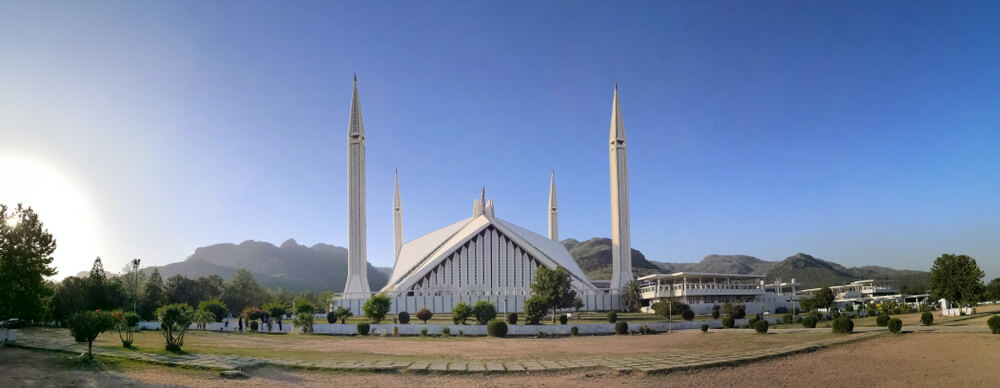
· Footwear is not allowed in the Mosque, so everyone must remove them before entering the courtyards.
· All visitors are expected to be dressed modestly as one should when visiting a sacred and religious place.
· Women should cover their heads before entering the Mosque.
· Eating or taking photographs inside the main hall is strictly not allowed.
· Non-Muslim Tourists and visitors are expected to stay outside the main prayer hall.
History About Faisal Masjid Islamabad
The history of the majestic Faisal Mosque dates back to 1966 when the late King of Saudi Arabia, Faisal Bin Abdul Aziz, visited Pakistan and proposed constructing a mosque in the beautiful green city surrounded by The Margala Hills. After three years of a long thought process, in 1969, an international competition was organized to gather some designs for the Mosque. Forty-three unique proposals were submitted by Architects coming from 17 different countries. After much scrutiny and inquiry, a Turkish architect, Vedat Dalokav, stood first in the competition. His unique grandeur design was approved for the largest Mosque in the world at that time.
The government of Pakistan allotted six acres of land at the foothills of the Merlin National Park.
Construction of the Mosque began in 1976 and was led by Azim Khan. After getting funds from the Government of Saudi Arabia, the National Construction of Pakistan started to work. Back in the 1970s, it cost over 130 million Saudi Riyals, which would equal 120 million US dollars today. King Faisal Bin Abdul Aziz was the main protagonist behind the funding and construction of this beautiful structure. To honor his memory, the Mosque and the road leading to it are named after him. King Faisal was assassinated in 1975.
King Faisal’s successor King Khalid Bin Abdul Aziz Al Saud, laid the foundation of the Mosque in October 1976.
The construction of the Faisal Mosque was finally completed in 1986. However, initially, it invited much criticism from staunch Muslims who could not deal with the Mosque’s unconventional design, especially the lack of a Dome structure. It is considered a must-have for any mosque. Once the Mosque was completed, the criticism started to die as abruptly as it started. The pearl-white Mosque perfectly combines the lush green Margalla hills. Worshipers gathered here on June 18, 1988, for the first prayer to be held in the Mosque. Since then, it has been open to the public, and everyone is welcome to join the prayers conducted five times daily.
The Architecture of Faisal Masjid Islamabad
As mentioned earlier, the most striking feature of the Shah Faisal Mosque is that it lacks traditional arches and domes, which are present in most other prominent mosques worldwide.
The exceptional architectural design of the Faisal Mosque makes it quite popular and appealing. The historic landmark has a triangular design inspired by a Bedouin tent that stands tall in the middle of a desert. Faisal Mosque is constructed on a total area of 10 canals and can accommodate up to 300 thousand people at a time. The interior of the Mosque is as spectacular as the exterior. Interestingly unlike many other mosques in Pakistan, Faisal Mosque has a separate hall for women. It also has a small gift shop, lecture hall, library, cafe, museum, and a large ablution area. Quaid e Azam Auditorium is used for conducting lectures and religious conferences.
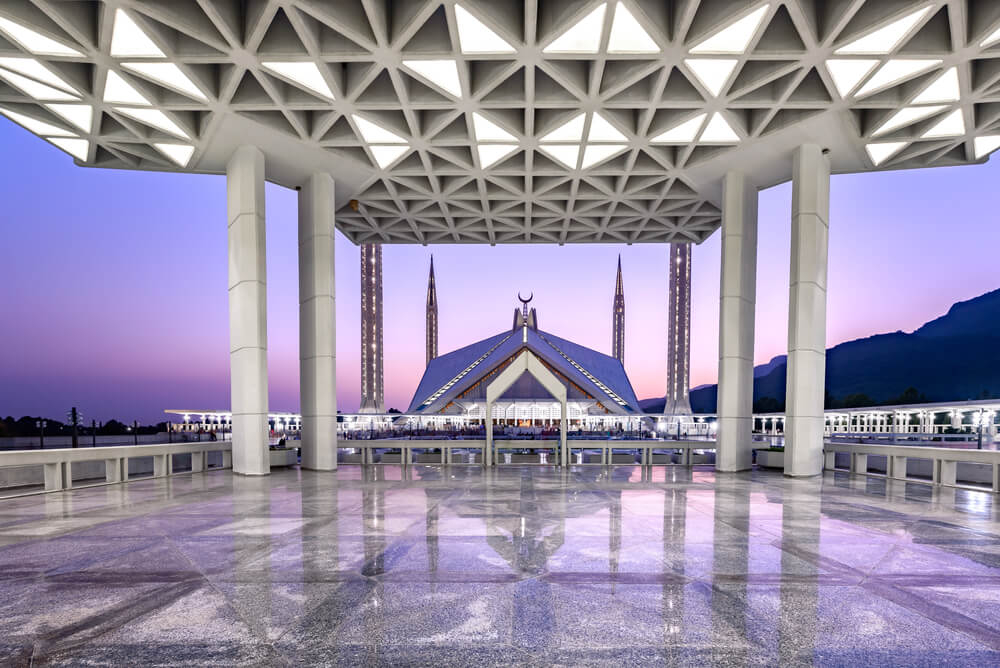
In 1988, the former President of Pakistan, General Muhammad Zia-Ul-Haq, died and was given a place adjacent to the Mosque. His funeral was also arranged in the Faisal Mosque, considered one of the large funeral congregations since the inception of Pakistan.
The extraordinary architecture and design of the Mosque make it an example of contemporary Islamic architecture. The Mosque is usually straightforward and cluttered, but it is still serene and peaceful.
Attractions Offered by Faisal Masjid for Visitors
Faisal Mosque has become a top tourist destination for locals and foreigners. It mostly remains full, so don’t look for less crowded times. Here are the top-notch features that make Faisal Mosque so spectacular.
Unusual Design of Faisal Mosque
Contradicting the conventional Southeastern Islamic architecture, the Mosque has an unusual design infused with contemporary lines and traditional Arab touch. Instead of a circle, it is a large triangular prayer hall with four minarets. The minarets have a Turkish touch as they are long and thin, like a pencil. The shape of Faisal Mosque is a combination of the shape of the Kaaba in Mecca and a conventional tent surrounded by Turkish architecture at four corners. The architect explained the design to be inspired by the Kaaba’s geometry, proportion, and spirit, the most sacred place on earth for Muslims.
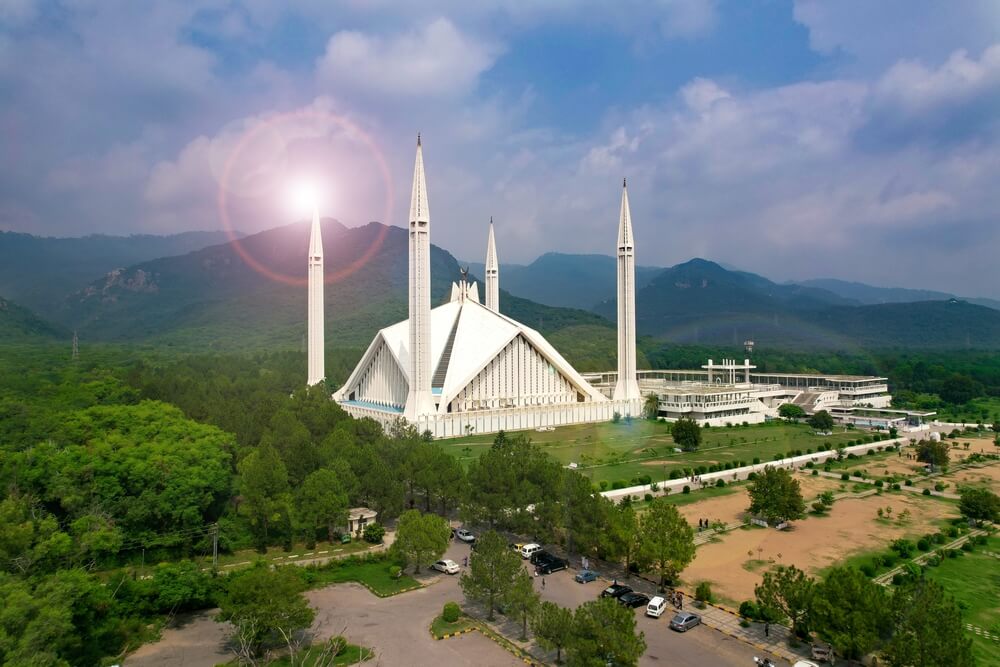
The entrance to the Faisal Mosque is set from the East, and there is a courtyard with access at the front of the prayer hall. Initially, Islamic International University was set up in the central Courtyard, but now it is relocated to a new campus in Islamabad. To make the interior of the Mosque equally beautiful, it is covered with white marble, which is also decorated with calligraphy and mosaics by famous Pakistani artists, including Sadequain. The Spectacular Turkish-style chandelier will grab your attention as soon as you enter the main hall. Kalima is written on the west wall using mosaic patterns in Kufic script.
Detailed Structure of Faisal Mosque
To discuss the structural details of the Mosque, let’s begin with the exterior. The tent-like structure of the Mosque has eight sides with sharp angles. Two hundred fifty-nine feet tall minarets surround the main concrete shell structure.
The circumference of each minaret is 10×10 meters. There are six golden crescents on the building of the Faisal Mosque. One Crescent on each minaret and a huge one on the top of the prayer hall. The central Crescent weighs more than 6 tons. Supporting structures are used to keep such a massive crescent in its place.
The Pearl white color of the Faisal Mosque on the outside is created by the white marble used to cover the entire construction of the Mosque. A remarkably well-maintained Courtyard and Gardens surround the Mosque. The Mosque has two ponds; one at the entrance and the other at the staircase leading to the main hall.
The minarets counterbalance the weight of the roof, just the way pillars are used to keep up the tent’s ceiling.
Moving inside the hall, you will notice a lot of light coming from all sides of the Mosque. The main hall is covered with blue carpet that stretches over 50000 square feet. At the center of the main hall, you will see a 6-ton chandelier made with gold anodized aluminum tubes. It has a diameter of 32 feet, with about 1100 small lights and 36 larger bulbs. The chandelier will awaken you awestruck because of its beauty and exceptional Turkish design.
The prayer niche is also known as the Mihrab. The white marble Mihrab looks like an open book in the main hall. A famous Pakistani artist Gulgi designed this Mihrab. At its center, the Mehrab showcases the Holy names of God written with gold-plated Copper. The two open book pages have engraved verses of the holy Quran.
The mimbar or pulpit is also decorated with another great artwork of Gulji. Embellished with white marble, the elegant and tall mimbar features another surah of the holy Quran; al Fatiha. All this work is done with gold plating, Copper, and lapis lazuli. There is a pool of running water right under the Qibla wall just behind the mimbar and the Mihrab. This wall faced the holy Kaaba of Mecca and was used as a direction of prayer and prostration. The shallow pool has ups and downs, which lowers and raises the water, inviting fresh air into the pool. The holes below the wall let the air in to keep the main hall cool and ventilated.
The Kibla wall is itself a piece of art. It is covered in mosaic tile imported from Turkey. The blue-colored fence is engraved with kalima e tawhid, which is the basis is the religion, Islam. The striking golden yellow writing says, ” There is no God but Allah, and Muhammad PBUH is the prophet of Allah.”
The north and south walls of the main hall store a handwritten copy of the Quran. It is 30 considerable volumes in a set of 30 cabinets. The women’s gallery is situated over the main entrance along the back wall. It is large enough to accommodate 1500 female worshippers. Traditional Mughal design is used to beautify the women’s gallery.
Visiting Faisal Mosque
Visitors are welcome to the Mosque at almost any time. However, non-Muslims are expected to avoid visiting on Fridays and prayer times since it is a worship area. No one can enter the Mosque without taking off their shoes. Counters are present at the entrance, where you can leave your shoes and proceed to the ablution area.
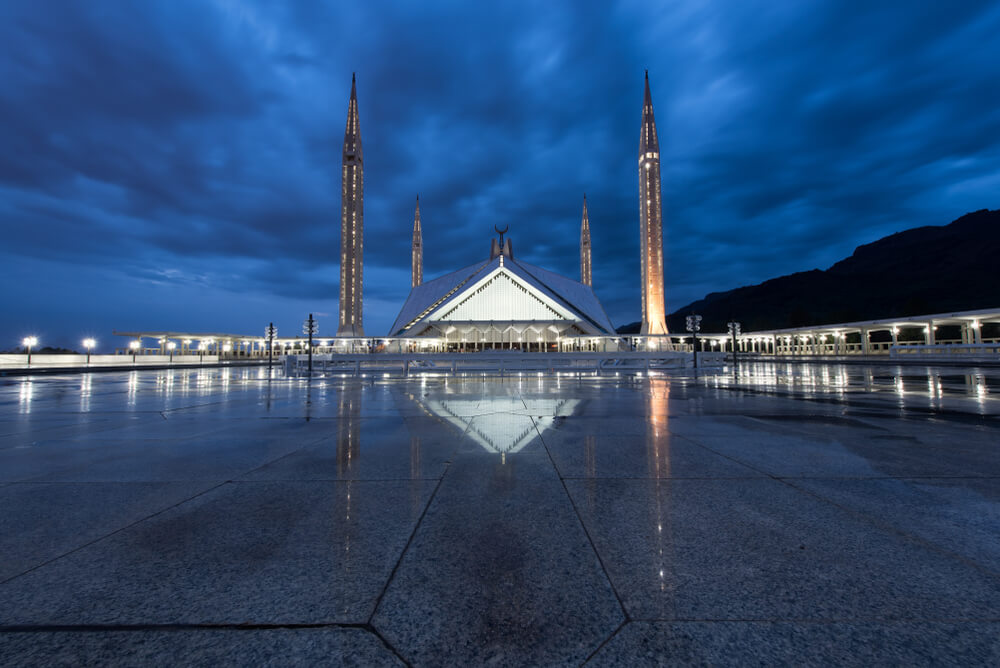
Also, remember to dress modestly before coming to any mosque. Women should come with their heads covered and fully clothed.
Perfect Place of Prayer at Faisal Mosque
Muslims must pray and prostrate to Allah several times a day. Praying is one of the essential pillars of the faith. Muslims can pray at home or anywhere clean, but coming to a mosque to offer prayers doubles the reward and strengthens your confidence and belief in God.
What else would be better to offer prayers than in a mosque where thousands of people gather five times a day!!
Huge Building- A Lot of Space
Faisal Mosque remained the world’s largest Mosque for quite some time. It can accommodate 300 thousand worshippers at a time. The main areas, including the inner hall and the Courtyards, can have up to 74000 people. The beautiful grounds around the park are also used for prayers on special religious occasions and Friday prayers. These grounds can hold up to 200,000 people.
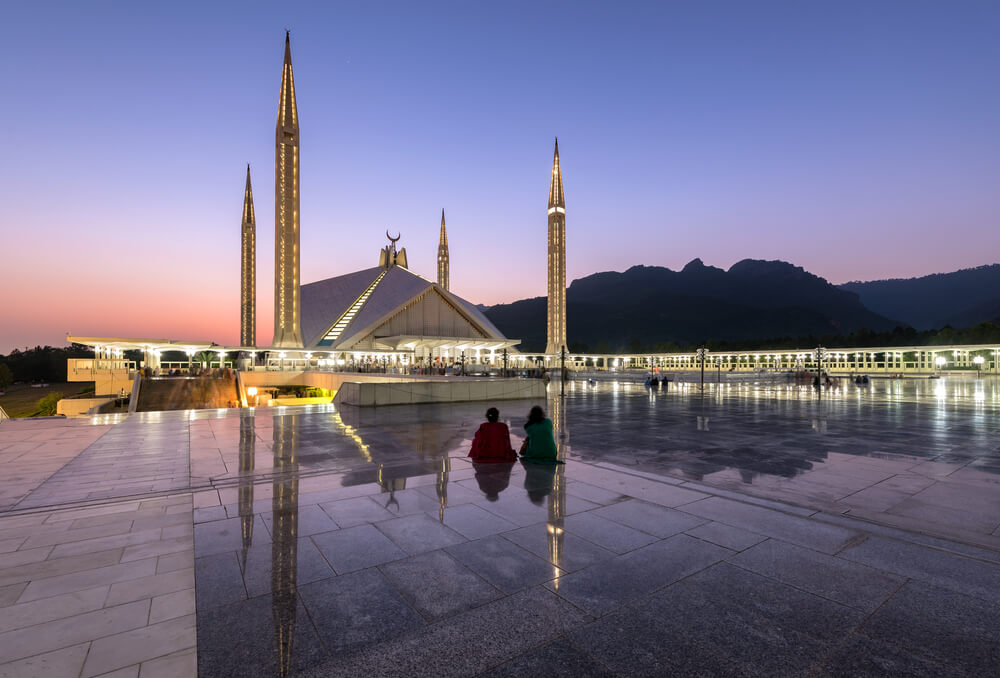
Women Have a Different Entrance at Faisal Mosque
Women have separate access to the main hall. It is enclosed following the protocols of a place where women can pray.
Topography of Faisal Mosque
Faisal Mosque is present at the foot of lush green and majestic Margalla hills. The background plays a significant role in the overall picture of the appearance of the Faisal Mosque. This unique structure can be seen from miles away since it is already constructed on the heightened ground. Faisal Mosque faces the city and looks even more appealing because of the cool weather of the town, which matches the vibe. No wonder why this design was selected out of 43 proposals. Faisal avenue leads straight to the Mosque, making it easily accessible so anyone can visit the Mosque easily.
Islamic Art at Faisal Mosque
Faisal Mosque is an enchanting attraction for tourists from around the world. Even though it has modern architecture and is popular among the masses for its elegance, serenity, and design, it is still a religious site closely associated with the Muslim faith and beliefs. The Mosque is filled with Islamic art to bloom the essence of the religion. Every inch of the Mosque accurately depicts the religion. Revelations from the Quran are engraved in several places in the Mosque. Beautiful lanterns, chandeliers, carpets, marbles, and mosaics are used to decorate it. However, considering how simplicity is praised in Islam, the interior of the Mosque is not too grand. It’s eye-catching and incredible but still gives a reflection of the beliefs of Muslims. Classic and contemporary Islamic architecture inspired the design of the Faisal Mosque.
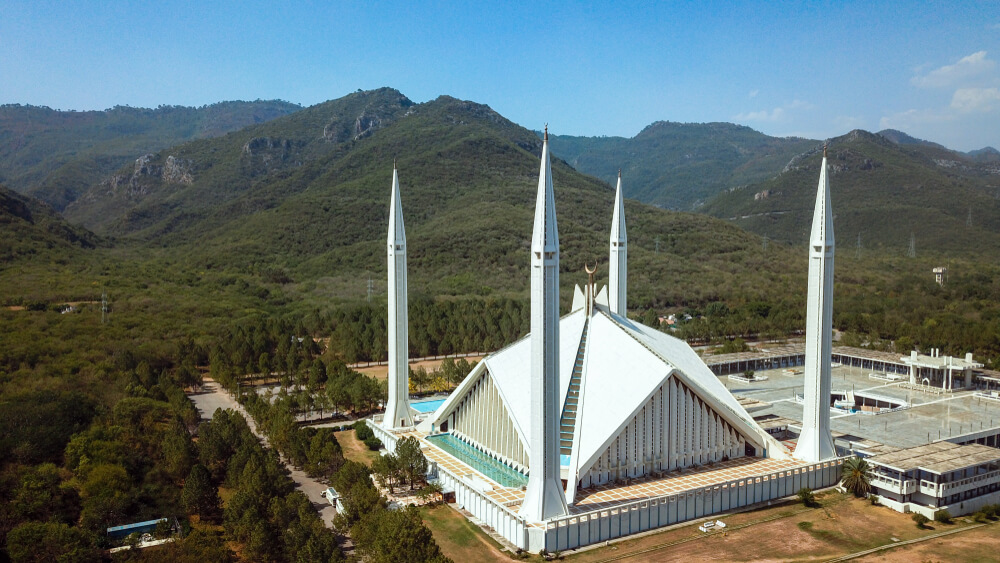
Faisal Masjid Entrance Tickets
There is no entrance ticket to visit the Faisal Mosque. But if you want to have in-depth knowledge about this magnificent structure, book a guided tour. Your guide will explain the tiny details about the fantastic architecture and Islamic art displayed in the Mosque.
Faisal Masjid Timings
Like any other mosque or prayer area, Faisal Mosque is open from dawn to dusk. People gather in the Mosque before the sun comes out to pray Fajr. The Mosque can be visited until the day’s last prayer: Isha. During Ramadan, people can stay in the Mosque at night for additional blessings and salutations.
Location & Contact Info
Shah Faisal Ave, E-8, Islamabad, Islamabad Capital Territory 44000.
The Faisal Mosque administration can be contacted at (051) 2854860.
Conclusion
Faisal Mosque is one of the most famous architectural wonders of the country. It is located in Islamabad at the foot of the Margala national park. It is the largest Mosque in South Asia and the world’s eighth Mosque. Faisal Mosque remained the world’s largest between 1986 and 1993.
The project was an idea of the late King Faisal Bin Abdul Aziz, who also financed the project. Faisal Mosque is a Marvel selected from 43 designs. Even though it is not a conventional Mosque with a dome but resembles a Bedouin tent, and sleek Turkish minarets, they are slender and pencil-shaped, with the Crescent on the top of each. Another Crescent is installed on the top of the main hall.
It is the most popular tourist destination in Islamabad, visited by millions of people annually. Guided tours are also offered to those interested in the history and architecture of the Mosque.
Make sure to dress conservatively before entering the Mosque.
FAQs
Why is Faisal Masjid famous?
Faisal Mosque is located in an elevated area against the beautiful backdrop of the Merlin National Park. It is popular because it remained the world’s largest Mosque from 1986 to 1993 until a mosque in Morocco finally overtook it. Faisal Mosque is famous for its incredible and unique architecture and serene outlook.
Who is buried in the Faisal Mosque?
No one is concealed inside the Faisal Mosque. However, general Zia ul Haq, the president and chief of the Army staff of Pakistan, is buried adjacent to the Shah Faisal Mosque. The Government of Pakistan held a state funeral and buried the general with military Honours after he died in a plane crash. His tomb is also crafted with white marble.
Who is the owner of Faisal Mosque?
Faisal Mosque is a government-owned asset that was erected with the funding allotted by the Saudi government. King Shah Faisal bin Abdul Aziz was the man behind the idea. Chosen by president Marshal Ayub Khan and the project was completed with the cooperation of the Saudi and Pakistani governments.
Who is Faisal Mosque named after?
The Mosque is named after King Faisal Bin Abdul Aziz of Saudi Arabia. He supported the idea of making the largest Mosque in the world in Islamabad and also financed the project. Faisal Mosque is now conceived as the National Mosque of Pakistan since it is undoubtedly one of the most famous landmarks in the country.
